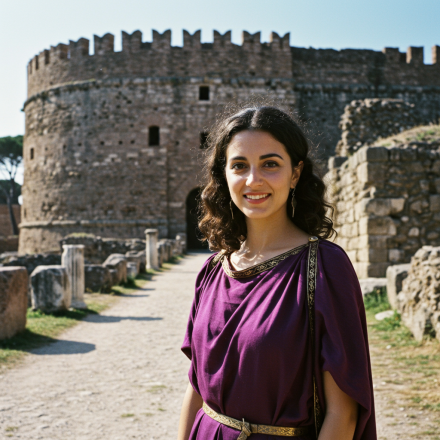Chainmail, also known as mail or maille, is a type of armor made from interlocking metal rings, used to protect warriors in battle during the Middle Ages. The process of making chainmail was a complex and time-consuming task, requiring skilled craftsmen and specialized tools. In this article, we will explore the history, materials, techniques, and variations of chainmail in medieval times.
The History of Chainmail
Chainmail has a long and fascinating history, originating as early as the 4th century BCE in Ancient Greece1. Known as the linothorax, this early form of chainmail was made from layers of linen glued together and covered in thin metal strips or scales1. It was later adopted by the Romans, who called it the lorica hamata, and used it extensively during their conquests1.
While chainmail fell out of use in the early Medieval period, it resurfaced in the 9th century as Vikings and Normans adopted it as their armor of choice1. Later, in the 11th century, it became widely used by knights and soldiers throughout Europe1. Chainmail was also used beyond the battlefield, serving as protective clothing for butchers, woodsmen, and other laborers1. It even made an appearance in religious ceremony, as chainmail shirts were worn by Byzantine Orthodox priests as a symbol of piety and devotion1.
The word “chainmail” itself is a modern term, used to describe the interconnected rings that make up the fabric of the armor. The actual name for chainmail during the Middle Ages was simply “mail” or “maille,” derived from the Latin word “macula,” meaning mesh1.
Through its varied uses and forms, chainmail has played an important role throughout history, both on and off the battlefield. Understanding its origins and evolution provides a deeper appreciation for this iconic armor and its enduring legacy.
The Materials Used in Chainmail
Chainmail was an essential form of armor during the Middle Ages, providing protection to warriors and influencing the outcome of battles. The materials used in chainmail were mainly iron and steel, which were abundant and relatively cheap in Europe2. However, other metals such as bronze, copper, silver, and gold were also used for decorative or ceremonial purposes2.
The process of making chainmail involved several steps, including wire drawing, ring formation, and weaving2. Wire drawing was the process of pulling metal rods through progressively smaller holes to create thin and uniform wires2. Ring formation was the process of coiling the wires around a mandrel, a metal rod of a desired diameter, and then cutting them into individual rings2. Weaving was the process of linking the rings together to form a mesh-like fabric2.
The most common method of weaving chainmail was to link each ring with four others, creating a pattern known as 4-in-13. This method was simple, strong, and flexible, allowing for ease of movement while still providing a high level of protection3. However, other methods of weaving chainmail existed, such as 6-in-1, 8-in-1, and 12-in-1, which involved linking each ring with more rings, creating denser and heavier fabrics3.
The rings used in chainmail were either riveted or butted3. Riveted rings were closed by inserting a small metal pin through the ends of the ring and hammering it flat, creating a secure and durable connection3. Butted rings were closed by simply bending the ends of the ring together, creating a weaker and less reliable connection3. Riveted rings were preferred for combat, as they could withstand more force and wear, while butted rings were used for decorative or non-functional purposes3.
The quality and appearance of chainmail varied depending on the skill of the craftsman, the availability of the materials, and the preferences of the wearer. Chainmail could be dyed, painted, or plated with different metals to create different colors and patterns3. Chainmail could also be tailored to fit different body shapes and sizes, and to cover different body parts, such as the head, torso, arms, and legs3.
The Variations and Uses of Chainmail
Chainmail was a versatile and adaptable form of armor, which could be modified and combined with other types of armor to suit different needs and situations. Some of the common variations and uses of chainmail in medieval times were:
- Hauberk: A hauberk was a long chainmail shirt that covered the torso and the upper legs, and sometimes had sleeves and a hood3. It was the most basic and common type of chainmail armor, worn by both infantry and cavalry3.
- Haubergeon: A haubergeon was a shorter chainmail shirt that covered the torso and the upper arms, and sometimes had a hood3. It was lighter and more comfortable than a hauberk, but offered less protection3.
- Coif: A coif was a chainmail hood that covered the head and the neck, and sometimes had a face mask or a ventail3. It was worn under a helmet or by itself, to protect the head from cuts and blows3.
- Aventail: An aventail was a chainmail curtain that hung from the back and sides of a helmet, covering the neck and the shoulders3. It was used to protect the exposed areas of the neck and the throat, and to prevent the helmet from being pulled off3.
- Mantle: A mantle was a chainmail collar that covered the neck and the upper chest, and sometimes had shoulder pads or a cape3. It was worn over a hauberk or a haubergeon, to reinforce the protection of the vital areas3.
- Chausses: Chausses were chainmail leggings that covered the legs and the feet, and sometimes had stirrups or sabatons3. They were worn over trousers or by themselves, to protect the legs from slashes and stabs3.
- Gloves: Gloves were chainmail mittens or gauntlets that covered the hands and the wrists, and sometimes had fingers or knuckles3. They were worn over gloves or by themselves, to protect the hands from cuts and bruises3.
- Mail and Plate: Mail and plate was a combination of chainmail and plate armor, where chainmail was used to cover the gaps and joints between the plates, or to supplement the plates in areas that required more flexibility3. It was used to increase the overall protection and mobility of the wearer, and to reduce the weight and cost of the armor3.
Chainmail, a groundbreaking invention of the Middle Ages, reshaped both warfare and fashion. Its creation demanded expertise and labor, serving as a symbol of prestige and individuality while embodying the wearer’s cultural identity. As a testament to history and ingenuity, it continues to inspire generations.



Leave a Comment